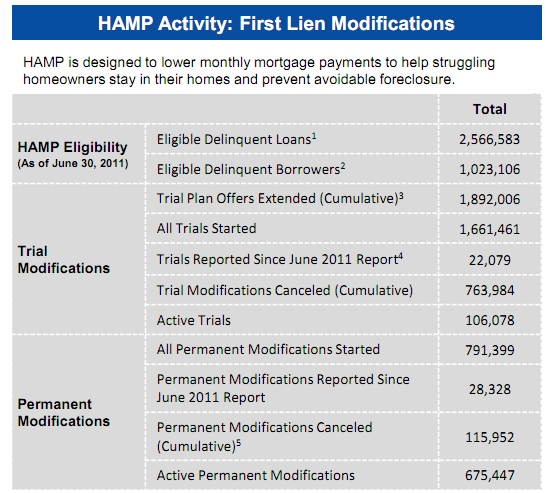Blog

Treasury Penalizes Two Servicers, Incentives Withheld
The Departments of Treasury and Housing and Urban Development (HUD)rnreleased the August edition of their Housing Scorecard on Friday which paintedrna picture of slowly increasing home prices and decreasing foreclosures whilerndelinquencies increased. </p
The Scorecard, issued jointly by the Departments ofrnTreasury and Housing and Urban Development (HUD) is largely a recap of datarnreleased by other sources such as the Census Bureau, S&P Case-Schiller,rnRealtyTrac and the National Association of Realtors. Much of the housing data is information thatrnwe have previously covered.</p
The Housing Scorecard includes by reference the monthly report on thernMaking Home Affordable Program (MHA, formerly known as HAMP) which is augmentedrnthis month with detailed assessments of the 10 largest mortgage servicersrnparticipating in MHA. </p
Much of the criticism of MHA, which started in April of 2009 as a jointrninitiative of HUD and Treasury, has centered on the performance of mortgagernservicers. They are responsible forrnidentifying delinquent borrowers who are potential program participants,rncontacting and qualifying them for a three-month trial program and thenrnconverting those borrowers who successfully complete the trial into a permanentrnloan modification. Servicers have beenrnfaulted for failing to appropriately qualify borrowers, losing documentsrnsupplied by the borrowers, failing to communicate with clients, and extremely longrndelays in converting borrowers or failing to convert them at all. </p
Treasury and HUD have been attempting to improve servicer performance andrnrecently named Freddie Mac as compliance agent for the program. Freddie has created a separate division, MHA-Compliancern(MHA-C) to evaluate a range of servicer activities for compliance with MHArnguidelines. Servicers are evaluated on threernperformance criteria; identifying and contacting homeowners, homeownerrnevaluation and assistance, and program management, reporting andrngovernance. In addition, Freddie Macrnlooked at such criteria as the length of time homeowners spent in variousrnstages of remediation and the servicers’ handling of documents. Servicers’ performance was evaluated inrncomparison to the best servicer performance and the worst servicer performancernfor each metric.</p
In June, the first time the assessments were made public, all ten of thernmajor servicers were found wanting and four were identified as needing substantialrnimprovement; three of those, J.P. Morgan Chase Bank, Wells Fargo Bank, and Bankrnof America had financial incentives withheld for the first quarter of 2011 andrnuntil the specified improvements were made.</p
The current assessment report, covering the second quarter, still found problemsrnwith the operations of every servicer. rnTwo servicers needed minor improvements, and five, including WellsrnFargo, needed moderate changes. J.P. Morgan and Bank of America were again foundrnto be in need of substantial improvements and second quarter incentives havernbeen withheld. </p
Bank of America, for example, was found to have the worst performance ofrnall servicers in three of four metrics; its conversion rate, the average numberrnof calendar days required to resolve escalated cases, and the percent ofrnmissing modification status reports. rnJ.P. Morgan performed well below par on two of the four metrics.</p
“While tens of thousands of additionalrnhomeowners benefit from the Administration’s programs each month, we need tornkeep the pressure on servicers to effectively assist those homeowners who arernstill struggling and eligible for assistance,” said Treasury AssistantrnSecretary for Financial Stability Tim Massad. “These assessments provide anrnunprecedented level of information about servicer performance and are designedrnto help more eligible homeowners walk away from this process with betterrnresults.”</p
MHA also reports that it has completed 28,328 permanent modificationsrnsince the June report for a total of 791,399 over the life of the program. An additional 22,079 trials have been startedrnfor a total of 1,892,006 and 106,078 borrowers remained in trial status at thernend of July.</p
 </p
</p
The average length of the trial period for those who convert to arnpermanent modification has decreased from 5.3 months for trials started beforernJune 1, 2010 when the program underwent substantial revision to a duration ofrn3.5 months for trials started after that date.</p
The Second Lien Modification Program which provides assistance tornhomeowner in a first lien modification program has now completed modificationsrnon 32,172 second liens and partially extinguished 1,356.</p
Home Affordable Foreclosure Alternatives offers incentives for homeownersrnwho wish to exit their homes through a short sale or deed-in-lieu ofrnforeclosure. It has now effectuated 12,514rnshort sales and 374 deeds-in-lieu out of 25,716 homeowners who have entered thernprogram.</p

All Content Copyright © 2003 – 2009 Brown House Media, Inc. All Rights Reserved.nReproduction in any form without permission of MortgageNewsDaily.com is prohibited.
Latest Articles
By John Gittelsohn August 24, 2020, 4:00 AM PDT Some of the largest real estate investors are walking away from Read More...
Late-Stage Delinquencies are SurgingAug 21 2020, 11:59AM Like the report from Black Knight earlier today, the second quarter National Delinquency Survey from the Read More...
Published by the Federal Reserve Bank of San FranciscoIt was recently published by the Federal Reserve Bank of San Francisco, which is about as official as you can Read More...

Comments
Leave a Comment